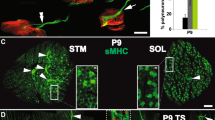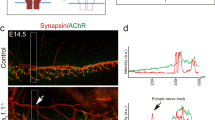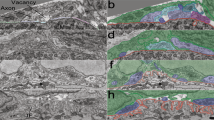Abstract
OF numerous synaptic components that have been identified, perhaps the best-studied are the nicotinic acetylcholine receptors (AChRs) of the vertebrate neuromuscular junction1. AChRs are diffusely distributed on embryonic myotubes, but become highly concentrated (~ 10,000 µm-2) in the postsynaptic membrane as development proceeds. At least two distinct processes contribute to this accumulation. One is local synthesis: subsynaptic muscle nuclei transcribe AChR subunit genes at higher rates than extra-synaptic nuclei, so AChR messenger RNA is concentrated near synaptic sites2,3. Second, once AChRs have been inserted in the membrane, they form high-density clusters by tethering to a sub-synaptic cytoskeletal complex. A key component of this complex is rapsyn, a peripheral membrane protein of relative molecular mass 43K (refs 4, 5), which is precisely colocalized with AChRs at synaptic sites from the earliest stages of neuromuscular synaptogenesis6. In heterologous systems, expression of recombi-nant rapsyn leads to clustering of diffusely distributed AChRs, suggesting that rapsyn may control formation of clusters7,8. To assess the role of rapsyn in vivo, we generated and characterized mutant mice with a targeted disruption of the Rapsn gene. We report that rapsyn is essential for the formation of AChR clusters, but that synapse-specific transcription of AChR subunit genes can proceed in its absence.
This is a preview of subscription content, access via your institution
Access options
Subscribe to this journal
Receive 51 print issues and online access
$199.00 per year
only $3.90 per issue
Buy this article
- Purchase on Springer Link
- Instant access to full article PDF
Prices may be subject to local taxes which are calculated during checkout
Similar content being viewed by others
References
Hall, Z. W. & Sanes, J. R. Cell 72/Neuron 10 (suppl.) 99–121 (1993).
Merlie, J. P. & Sanes, J. R. Nature 317, 66–68 (1985).
Chu, G. C., Velleca, M. A. & Merlie, J. P. Sem. dev. Biol. 6, 175–183 (1995).
Neubig, R. R., Krodel, E. K., Boyd, N. D. & Cohen, J. B. Proc. natn. Acad. Sci. U.S.A. 76, 690–694 (1979).
Frail, D. E., McLaughlin, L. L., Mudd, J. & Merlie, J. P. J. biol. Chem. 263, 15602–15607 (1988).
Noakes, P. G., Philips, W. D., Hanley, T. A., Sanes, J. R. & Merlie, J. P. Devl Biol. 155, 275–280 (1993).
Froehner, S. C., Luetje, C. W., Scotland, P. B. & Patrick, J. Neuron 5, 403–410 (1990).
Phillips, W. D. et al. Science 251, 568–570 (1991).
Gautam, M. et al. Genomics 24, 366–369 (1994).
Musil, L. S., Frail, D. E. & Merlie J. P. J. Cell Biol. 108, 1833–1840 (1989).
Merlie, J. P., Heinemann, S. & Lindstrom, J. M. J. biol. Chem. 254, 6320–6327 (1979).
Ferns, M., Campanelli, J. T., Hoch, W., Scheller, R. H. & Hall, Z. W. Neuron 11, 491–502 (1993).
Sanes, J. R. et al. Development 113, 1181–1191 (1991).
Ervasti, J. M. & Campbell, K. P. Curr. Opin. Cell Biol. 5, 82–87 (1993).
Tinsley, J. M. et al. Nature 360, 591–593 (1992).
Yang, B., Ibraghimov-Beskrovnaya, O., Moomaw, C. R., Slaughter, C. A. & Campbell, K. P. J. biol. Chem. 269, 6040–6044 (1994).
Yoshida, M. & Ozawa, E. J. Biochem, Tokyo 108, 748–752 (1990).
Kramarcy, N. R., Vidal, A., Froehner, S. C. & Sealock, R. J. biol. Chem. 269, 2870–2876 (1994).
Ibraghimov-Beskrovnaya, O. et al. Nature 355, 696–702 (1992).
Apel, E. D., Roberds, S. L. Campbell, K. P. & Merlie J. P. Neuron 15, 115–126 (1995).
Buckley, K. & Kelly, R. B. J. Cell Biol. 100, 1284–1294 (1985).
Sanes, J. R. Sem. dev. Biol. 6, 163–173 (1995).
LaRochelle, W. J., Ralston, E., Forsayeth, J. R., Froehner, S. C. & Hall, Z. W. Devl Biol. 132, 130–138 (1989).
Lupa, M. T. & Hall, Z. W. J. Neurosci. 9, 3937–3945 (1989).
Tybulewicz, V. L. J., Crawford, C. E., Jackson, P. K., Bronson, R. T. & Mulligan, R. C. Cell 65, 1153–1163 (1991).
Chu, G. C., Moscoso, L. M., Sliwkowski, M. X. & Merlie, J. P. Neuron 14, 329–339 (1995).
Moscoso, L. M., Merlie, J. P. & Sanes, J. R. Molec. cell. Neurosci. 6, 80–89 (1995).
Crowder, C. M. & Merlie, J. P. Molec. cell. Biol. 8, 5257–5267 (1988).
Noakes, P. G., Gautam, M., Mudd, J., Sanes, J. R. & Merlie, J. P. Nature 374, 258–262 (1995).
Ohlendieck, K. et al. Neuron 7, 499–508 (1991).
Author information
Authors and Affiliations
Rights and permissions
About this article
Cite this article
Gautam, M., Noakes, P., Mudd, J. et al. Failure of postsynaptic specialization to develop at neuromuscular junctions of rapsyn-deficient mice. Nature 377, 232–236 (1995). https://doi.org/10.1038/377232a0
Received:
Accepted:
Issue Date:
DOI: https://doi.org/10.1038/377232a0
This article is cited by
-
Immune-mediated myogenesis and acetylcholine receptor clustering promote a slow disease progression in ALS mouse models
Inflammation and Regeneration (2023)
-
Neuromuscular junction-specific genes screening by deep RNA-seq analysis
Cell & Bioscience (2021)
-
Synapse-specific Lrp4 mRNA enrichment requires Lrp4/MuSK signaling, muscle activity and Wnt non-canonical pathway
Cell & Bioscience (2021)
-
The association between RAPSN methylation in peripheral blood and breast cancer in the Chinese population
Journal of Human Genetics (2021)
-
Postsynaptic CaV1.1-driven calcium signaling coordinates presynaptic differentiation at the developing neuromuscular junction
Scientific Reports (2019)
Comments
By submitting a comment you agree to abide by our Terms and Community Guidelines. If you find something abusive or that does not comply with our terms or guidelines please flag it as inappropriate.



